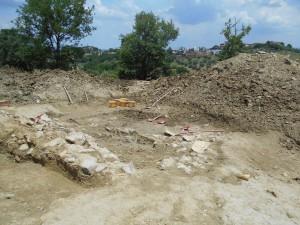Stephanie Felt / Penn Museum
Source - http://www.penn.museum/blog/museum/a-glance-into-the-lives-of-the-roman-peasantry-four-weeks-of-excavation-with-the-roman-peasant-project/

Ceramics from the Tombarelle site
This summer, I had the pleasure of being accepted to be a part of the sixth and final season of the Roman Peasant Project. I excavated alongside a team of professional archaeologists, professors, and graduate, PhD, and undergraduate students in rural Tuscany in Cinigiano, a municipality in the Province of Grosseto. The site we excavated was called Tombarelle. The Roman Peasant Project, directed by Kim Bowes, Cam Grey, Emanuele Vaccaro, and Mari Ghisleni, is one of very few archaeological excavations that seeks to uncover and investigate the lifestyles of peasants in the Roman period. Since a great majority of the material culture of Roman antiquity represents persons of wealth and status, this project is very important for expanding the views gathered from these traditional sources. Being the final season of the project, I was very excited to learn of the accumulation of data over the years and the conclusions drawn from the evidence discovered across rural Tuscany.
Having had no previous experience in archaeology, with the exception of an introductory course taken during the first semester of my freshman year, I quickly learned the elementary concepts of rescue-style excavation. Unlike tradition excavation, this style of archaeology requires the digging and investigation of an area to occur at a brisk pace. The four trenches we excavated were first discovered through use of an archaeological survey. They were dug quickly and were some of the many areas of interest for excavation in Cinigiano. Following the survey, an excavator was called to remove the first few layers of soil, and we began the excavation by troweling in order to clean the trenches. It was quite a funny thing for one to “clean” dirt, and I have to say, I enjoyed every minute of it.
Discovering artifacts and new methods of surveying was both a very entertaining and exciting endeavor. Within the first week, we began work with pick axes and shovels and discovered our first finds of the excavation, with many of them dating from the fifth century AD. When a found had been made, a series of happy squeals emanated from those of us new to the field of archaeology. By the end of the second week, I had not only worked on every area of the dig site, but also had also learned to take measurements with a dumpy level. This required me to look through a leveled instrument to read certain heights on a measurement stick, almost like peering through a telescope at a vertical ruler. After taking the level of a small find and a fixed point, a small amount of math was applied to find the height of the artifact in respect to the sea level. Whenever such a prominent small find was uncovered, like a piece of Roman glass, for example, a dumpy level and a total station would be the instruments used to document the location of said small find.

Trench 17000 of the Tombarelle site
I worked primarily in two trenches during the duration of the excavation. For the first week and a half, I worked mainly on a structure thought to be a cistern. By the end of the dig, we discovered that it had, indeed, been used as a cistern during Roman times but had been reconditioned to serve as a basement of a medieval tower. It was in trench 17000, however, where I spent most of the hours and the remaining two and a half weeks of the excavation. During the third week of excavating trench 17000, we uncovered a tile floor, mostly flat. This floor was surrounded on two sides by what appeared to be walls. This building could very well have been a Roman house. In addition to learning the physical aspects of an archaeological excavation, I learned how to fill out context sheets for my trench and transcribe the written context sheets onto a computer database.
Our finds led us to question the complexity of what a Roman peasant truly was. The peasants we studied in Cinigiano lived in rural societies. It is unknown, however, if they were as poverty-stricken as traditional views would relay. It was interesting to discover that the evidence from the material culture we unearthed suggested that the Roman peasants of this area had a great knowledge of the world outside of their farms and agricultural societies. Throughout the course of the dig, we unearthed pottery sherds, including some pieces of Terra sigillata, animal bone fragments, and pieces of tile and imbrex. Many of the pottery sherds we found were from pots and amphora that were replicas of original pieces found elsewhere across the Roman Empire. Two particular potsherds that we found had leaf-like designs etched into the clay. The pottery specialists on the excavation confirmed that these particular pieces were, indeed, reproductions of the originals. In respect to the animal bones we found, which were the bones of both cows and pigs, some possessed gnaw marks while others did not. This could suggest that these animals, in addition to being raised for sustenance, were used for certain manufacturing purposes. The building we found, if not a house, could have been a tannery or a farm. It could have also served another industrial purpose. This suggests that these peasants were involved in the manufacturing of, importation, and exportation of goods for trade.